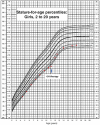Long-Term Follow-up of a Case with Proprotein Convertase 1/3 Deficiency: Transient Diabetes Mellitus with Intervening Diabetic Ketoacidosis During Growth Hormone Therapy
- PMID: 28588004
- PMCID: PMC5596812
- DOI: 10.4274/jcrpe.3986
Long-Term Follow-up of a Case with Proprotein Convertase 1/3 Deficiency: Transient Diabetes Mellitus with Intervening Diabetic Ketoacidosis During Growth Hormone Therapy
Abstract
Proprotein convertase 1/3 (PC1/3) deficiency is a very rare disease characterized by severe intractable diarrhea in the first years of life, followed by obesity and several hormonal deficiencies later. Diabetes mellitus requiring insulin treatment and diabetic ketoacidosis have not been reported in this disorder. We herein present a girl with PC1/3 deficiency who has been followed from birth to 17 years of age. She developed deficiencies of all pituitary hormones over time as well as diabetes mellitus while receiving growth hormone (GH) therapy. She was complicated with diabetic ketoacidosis during dietary management of diabetes mellitus, thus insulin treatment was initiated. Insulin requirement to regulate hyperglycemia was short-lived. Repeat oral glucose tolerance test five years later was normal. The findings of this patient show that diabetes mellitus can develop at any time during follow-up of cases with proportein convertase 1/3 deficiency especially under GH therapy.
Keywords: Proprotein convertase 1/3 deficiency; diabetes mellitus; diabetic ketoacidosis; treatment diabetes insipidus..
Figures
Similar articles
-
Congenital proprotein convertase 1/3 deficiency causes malabsorptive diarrhea and other endocrinopathies in a pediatric cohort.Gastroenterology. 2013 Jul;145(1):138-148. doi: 10.1053/j.gastro.2013.03.048. Epub 2013 Apr 2. Gastroenterology. 2013. PMID: 23562752 Free PMC article.
-
A New Case of PCSK1 Pathogenic Variant With Congenital Proprotein Convertase 1/3 Deficiency and Literature Review.J Clin Endocrinol Metab. 2019 Apr 1;104(4):985-993. doi: 10.1210/jc.2018-01854. J Clin Endocrinol Metab. 2019. PMID: 30383237 Review.
-
From diarrhea to obesity in prohormone convertase 1/3 deficiency: age-dependent clinical, pathologic, and enteroendocrine characteristics.J Clin Gastroenterol. 2013 Nov-Dec;47(10):834-43. doi: 10.1097/MCG.0b013e3182a89fc8. J Clin Gastroenterol. 2013. PMID: 24135795 Free PMC article.
-
Weekly Growth Hormone (Lonapegsomatropin) Causes Severe Transient Hyperglycemia in a Child with Obesity.Horm Res Paediatr. 2023;96(5):542-546. doi: 10.1159/000530522. Epub 2023 Apr 4. Horm Res Paediatr. 2023. PMID: 37015214
-
Steroid-Induced Diabetes Ketoacidosis in an Immune Thrombocytopenia Patient: A Case Report and Literature Review.Am J Case Rep. 2020 May 18;21:e923372. doi: 10.12659/AJCR.923372. Am J Case Rep. 2020. PMID: 32418984 Free PMC article. Review.
Cited by
-
Islet MC4R Regulates PC1/3 to Improve Insulin Secretion in T2DM Mice via the cAMP and β-arrestin-1 Pathways.Appl Biochem Biotechnol. 2022 Dec;194(12):6164-6178. doi: 10.1007/s12010-022-04089-y. Epub 2022 Jul 28. Appl Biochem Biotechnol. 2022. PMID: 35900711
-
Modulation of PC1/3 activity by a rare double-site homozygous mutation.Front Pediatr. 2022 Oct 31;10:1026707. doi: 10.3389/fped.2022.1026707. eCollection 2022. Front Pediatr. 2022. PMID: 36389395 Free PMC article.
-
Rare Heterozygous PCSK1 Variants in Human Obesity: The Contribution of the p.Y181H Variant and a Literature Review.Genes (Basel). 2022 Sep 27;13(10):1746. doi: 10.3390/genes13101746. Genes (Basel). 2022. PMID: 36292633 Free PMC article. Review.
-
A case of prohormone convertase deficiency diagnosed with type 2 diabetes.Turk Arch Pediatr. 2021 Jan 1;56(1):81-84. doi: 10.14744/TurkPediatriArs.2020.36459. eCollection 2021 Jan. Turk Arch Pediatr. 2021. PMID: 34013237 Free PMC article.
-
PROPROTEIN CONVERTASE 1/3 DEFICIENCY WITH PELVIC EWING SARCOMA.Acta Endocrinol (Buchar). 2022 Oct-Dec;18(4):508-511. doi: 10.4183/aeb.2022.508. Acta Endocrinol (Buchar). 2022. PMID: 37152885 Free PMC article.
References
-
- Seidah NG. The proprotein convertases, 20 years later. Methods Mol Biol. 2011;768:23–57. - PubMed
-
- Schaner P, Todd RB, Seidah NG, Nillni EA. Processing of prothyrotropin-releasing hormone by the family of prohormone convertases. J Biol Chem. 1997;272:19958–19968. - PubMed
-
- O’Rahilly S, Gray H, Humphreys PJ, Krook A, Polonsky KS, White A, Gibson S, Taylor K, Carr C. Brief report: impaired processing of prohormones associated with abnormalities of glucose homeostasis and adrenal function. N Engl J Med. 1995;333:1386–1390. - PubMed
-
- Bandsma RH, Sokollik C, Chami R, Cutz E, Brubaker PL, Hamilton JK, Perlman K, Zlotkin S, Sigalet DL, Sherman PM, Martin MG, Avitzur Y. From diarrhea to obesity in prohormone convertase 1/3 deficiency: age-dependent clinical, pathologic, and enteroendocrine characteristics. J Clin Gastroenterol. 2013;47:834–843. - PMC - PubMed
-
- Farooqi IS, Volders K, Stanhope R, Heuschkel R, White A, Lank E, Keogh J, O’Rahilly S, Creemers JW. Hyperphagia and early-onset obesity due to a novel homozygous missense mutation in prohormone convertase 1/3. J Clin Endocrinol Metab. 2007;92:3369–3373. - PubMed
Publication types
MeSH terms
Substances
Supplementary concepts
LinkOut - more resources
Full Text Sources
Other Literature Sources
Medical
Research Materials
Miscellaneous



